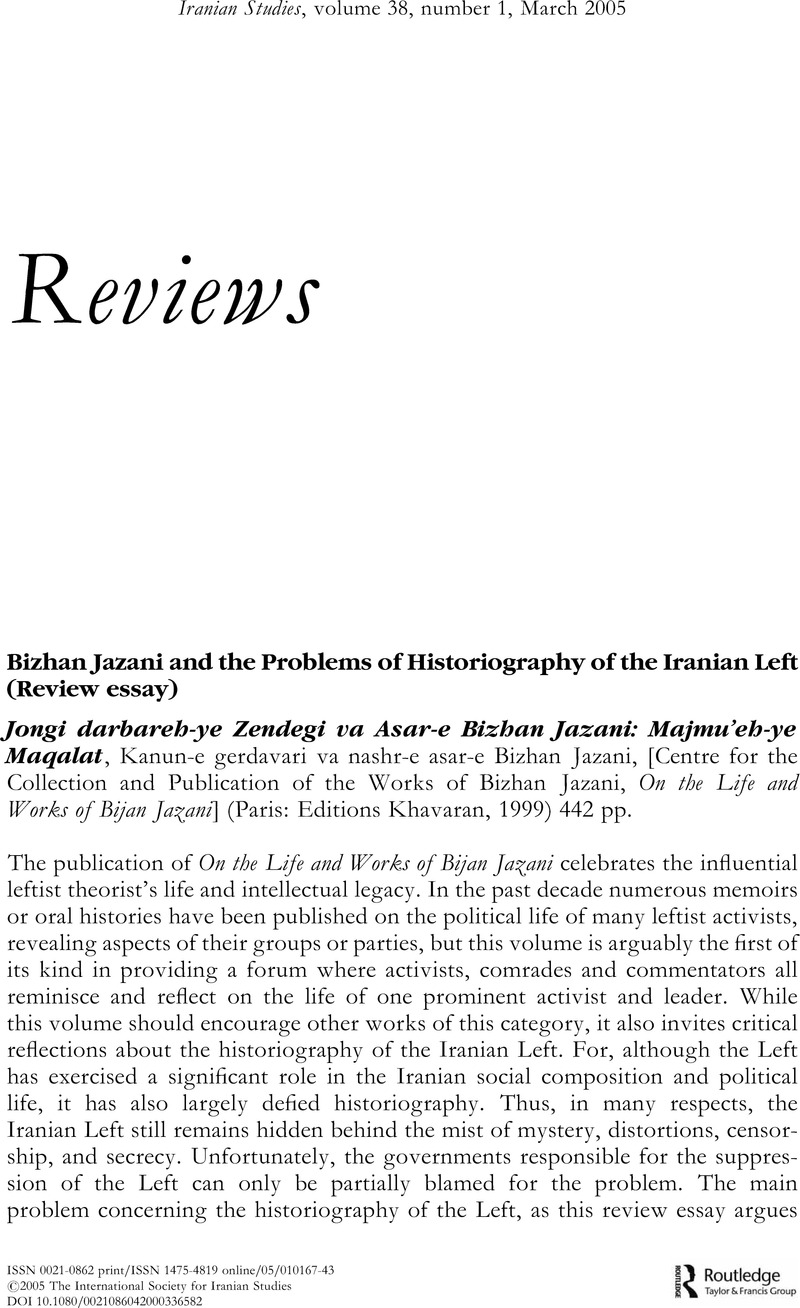Published online by Cambridge University Press: 01 January 2022

1 For a detailed history of the OIPFG see: Peyman Vahabzadeh, A Guerrilla Odyssey: Modernization, Secularism, Democracy and the Fadai Discourse of National Liberation in Iran, 1971–1979 (forthcoming), ch. 2.
2 On 18 April 1975, while serving his 15-year sentence, Jazani and seven other veteran prisoners (five of them members of Jazani's group, while two others members of Mojahedin-e Khalq) were picked up by a team of SAVAK agents and shot on the hills outside the Evin Prison in retaliation for the death of SAVAK agents assassinated by Fada'i guerrillas. The authorities declared that the prisoners were shot during an escape attempt. One of the SAVAK agents and a notorious interrogator, Bahman Naderipur, better known as Tehrani, was arrested after the 1979 Revolution and provided a detailed account of the assassination of Jazani and others on Iranian television (Keyhan 10714 [Wednesday 23 May 1979]). Tehrani was found guilty by the Islamic Revolutionary Court and subsequently executed.
3 Jazani, Bizhan, Tarh-e jam‘ehshenasi va mabani-ye estratezhi-ye jonbesh-e enqelabi-ye khalq-e Iran; baksh-e dovvom: tarikh-e si saleh-ye siyasi, fasl-e avval) [A Sketch of Sociology and Foundations of the Strategy of Iranian People's Revolutionary Movement; Second Part: The Thirty-Year Political History, Chapter One] (Tehran, Mazyar Publishers, 1979), 59Google Scholar. The work was originally published as: Bizhan Jazani, Tarikh-e si saleh-ye siyasi jeld-e dovvom [The Thirty-Year Political History, Second Volume] (np: np, nd).
4 Ibid., 60–61.
5 As regards Jazani's allegation also see: Chaqueri, C., “Historiography of the Iranian Left in the Twentieth Century: A Critical Appraisal” (paper originally delivered to the Conference on the History of the Iranian Left at the School of Oriental and African Studies, London, June 2000), 40, n. 206Google Scholar. Chaqueri reveals the Tudeh's line in such accusation by referring to the staged “memoirs” of Nurreddin Kianuri, the late General Secretary of the Party. See: Kiyanuri, Nurreddin, Khaterat-e Nurreddin-e Kiyanuri [Memoirs of Nurreddin Kiyanuri] (Tehran: Mo'asseseh-ye Tahqiqati va Entesharati-ye Didgah, 1992), 212Google Scholar. Kiyanuri tries to link Fatemi to Seyyed Zia who together with Reza Khan Pahlavi, in collaboration with British officals in Iran, led the coup d'etat of 1921.
6 See Katouzian, Homa, “The Strange Politics of Khalil Maleki” in Cronin, Stephanie, ed., Reformers and Revolutionaries in Modern Iran: New Perspectives on the Iranian Left, London and New York: Routeldge Curzon, 2004Google Scholar; “Khalil Maleki, The Odd Intellectual Out” in Nabavi, Negin, ed., Intellectual Trends in 20 th Century Iran, Florida: University of Florida Press, 2003Google Scholar; Khaterat-e siyasi-ye Kahlil Maleki, second edition, Tehran; Enteshar, 1988.
7 Jazani, A Sketch of Sociology, 86. In another pamphlet, on the history of the OIPFG, that Jazani wrote in prison (but was published unsigned), he recounts that theIranian Marxist-Leninists’ Process emerged after the 1953 coup and concentrated its activities against the Tudeh Party. Later, the Porosseh and its splinter group, the Communist Party, were described as “American Marxists” (Author Unknown, Goruh-e Jazani-Zarifi pishtaz-e jonbesh-e mosallahaneh-ye Iran [The Jazani-Zarifi Group: The Vanguard of Armed Movement in Iran] 19 Bahman-e Teorik 4 [April 1976], 9).
8 Jazani, A Sketch of Sociology, 105. Sho‘aiyan confirms that this was the analysis of the Jaryan group. (Sho‘aiyan, Mostafa, Shesh nameh-ye sargoshadeh beh Sazman-e Charikha-ye Fada'i-e Khalq-e Iran [Six Open Letters to the Organization of Iranian People's Fada'i Guerrillas] [Tehran: Edition Mazdak, 1980], 24, n. 3Google Scholar).
9 Jazani, A Sketch of Sociology, 106; Sho‘aiyan, Six Open Letters, 23, n. 3.
10 Jazani, A Sketch of Sociology, 168.
11 Jaryan Group, Chand maqaleh va tahqiq az goruh-e “Jaryan” (1335–1345) [Some Articles and Analyses by the “Jaryan” Group (1956–1966)], (np: np, September 1979 [Shahrivar 1358]), 3. On this note also see Behrooz, Maziar, Rebels with A Cause: The Failure of the Left in Iran (London/New York, 1999)Google Scholar. Since Behrooz's study covers a span of half-a-century, his account on this problem remains vague. According to Behrooz, Porosseh “was created in the late 1950s and was disbanded before 1970. The cell's members had associations with the Tudeh in the 1950s, but had developed Maoist tendencies and were basically involved in organizing group studies of Marxist texts. Prominent members of the cell were Mostafa Madani, Mostafa Sho'aiyan and Behrouz Rad. The first two joined the Fada'iyan in the 1970s” (46).
12 Sho‘aiyan, Six Open Letters, 23, n. 3.
13 Ibid., 22, n. 2.
14 Mostafa Sho‘aiyan, Enqelab [Revolution] (Florence, 1976). Sho‘aiyan has written over 3000 pages including theoretical works, a massive 500-page history of Mirza Kuchik Khan's movement in the Caspian region in 1920–21, policy studies, recollections and poetry.
15 I have provided a relatively detailed account of the relationship between Sho‘aiyan and the OIPFG in my study, A Guerrilla Odyssey, Chapter 6. The correspondence of Sho‘aiyan with the OIPFG were published after his death in two pamphlets, Six Open Letters and Sheshomin nameh-ye sargoshadeh beh cherik-ha-ye Fada'i [The Sixth Open Letter to People's Guerrillas] (Florence, 1976).
16 Fatapour, Mehdi, “Author's Telephone Interview with Mehdi Fatapour” (Vancouver, 24 November 2001)Google Scholar.